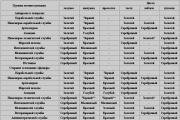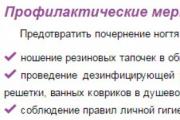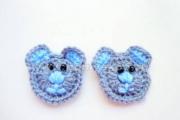Gluten cereals: benefit or harm. How and when to introduce complementary foods to infants. Gluten free baby cereals
What is gluten and is it really bad for your health? List of gluten-free products and table of gluten content in cereals and cereals.
What is gluten?
Gluten is a substance found in the protein of wheat, barley, rye and most other cereals. The more gluten the flour contains, the easier it is to make dough into fluffy pastries. The gluten content in high-grade wheat protein is up to 30%.
However, the intestinal mucosa returns to normal within a few months. Diagnosis of celiac disease Due to variability clinical manifestations diseases histological and laboratory tests have crucial to determine the diagnosis, in addition to a thorough history and physical examination.
Determination of antibodies in the blood - If you notice any of these difficulties, we recommend that you carry out a special laboratory examination. Read more: Endoscopic examination - by inserting a probe through the stomach to the small intestine, you can macroscopically visualize the mucous membrane and assess the presence or severity of small intestinal atrophy, as well as microscopic examination collected tissue samples, biopsy, small intestinal mucosa. Therapy, alternative and instrumental research, lectures, seminars and exhibitions.
Because gluten is essentially like glue (that's why it's called "gluten"), it is widely used to give sauces and other foods a thick texture. At the same time, gluten seems to glue the contents of the stomach together, causing inflammation and the development of food allergies in some people.
Why is gluten harmful?
It is important to separate the harm of products with gluten from the harm of gluten itself. Since gluten is the main component of wheat flour, it is large quantities found in bread and all baked goods. It is this type of food that causes rapid weight gain, while avoiding it is beneficial for weight loss.
It's not surprising that there is a close connection between a person's blood types and what they should eat. There are many books and more experts on board on blood types that don't match the number of views. However, several principles can be summarized in a few points.
Prehistoric people probably ate a diet consisting of raw wild plants, worms and the remains of other animals caught by predators and not finished. Meat became their main source of energy. There were carriers of the blood type of hunters in search of prey from Africa, progressing steadily and the Cadian continent has not yet been finally settled, with the exception of Antarctica. The settlers began to pay agriculture and domestication of animals, large changes in diet and environment led to transformation of the gastrointestinal tract and immune system.
On the other hand, the immune system of some people perceives gluten as an allergen, forcing the body to “fight” it. Since gluten comes from food, the stomach is the first to suffer. Intestinal functions are disrupted, the level of absorption of carbohydrates, fats, vitamins and minerals decreases.
Celiac disease - gluten allergy
A disease called celiac disease, which is an allergy to gluten, affects 1% of the population - on average, one in 100-150 people(2). U similar people consuming even minimal doses of gluten (0.1 g) can cause a serious food allergy with unpleasant symptoms.
This allowed them to better tolerate a variety of cultural foods. The Mongols are dedicated herders and the domestication of animals also reflects their diet of meat and dairy products. If he finds something foreign that has come, he immediately begins to produce antibodies against it. When antibody occupants collide, a reaction called agglutination occurs - precipitation, which makes the foreign antigen sticky and agglomerates into easily identifiable units to facilitate their removal work. A similar agglutination property that affects our blood is lectin - a variety of proteins in food.
It is believed that gluten intolerance is genetic disease, similar to lactose intolerance. If your parents or relatives have celiac disease, you are probably also susceptible to it. In this case, you will have to adhere to a strict gluten-free diet for the rest of your life.
Symptoms of Gluten Allergy
Most symptoms of gluten intolerance relate to dysfunction digestive system- chronic bloating, constant diarrhea and other stomach disorders. In many cases, the stool becomes pale and foamy, with a strong, unpleasant odor (2).
Fortunately, only 5% of lectins are filtered into the blood stream; they are, however, react with red and white blood cells and destroy them. So if we eat foods that contain lectin - antigens that are not compatible with your blood type antigens, the lectin can affect the organ system and stick cells together. Simply put, if a person with blood type 0 drinks milk that has lectins similar to the antigen, the system immediately starts the agglutination system, which regurgitates the milk. Lectin's activity gastrointestinal tract may lead to aggressive intestinal mucositis.
Secondary symptoms of gluten allergy are headaches, hair loss, decreased immunity, and decreased metabolism. Given the mild severity of symptoms, diagnosing celiac disease is often difficult, and many patients are not even aware of their disease.
A way to detect gluten intolerance
A simple home remedy for identifying gluten intolerance is to eliminate bread and any other gluten-containing foods from your diet for a few days and carefully evaluate how you feel. The subsequent return of these products to the diet will be significant.
For example, the best-known lectin, gluten, found in grains binds to the lining of the small intestine and causes inflammation and irritation, especially in people with the blood type. It follows that it is not easy to navigate this area. This division is really informative and different authors with minor differences. If you have health problems, it is very important that we consume only suitable foods. As a consequence of these difficulties, it is enough for us to miss only unsuitable food.
Focus on the foods you eat, not what you should eliminate
Are you afraid that you might get hurt? Have you been diagnosed with celiac disease? If you're on a gluten-free diet, these 10 tips will show you that even this diet is varied, tasty, and not just dry rice and potatoes. A positive approach is the basis of every success. You need to reset the bread and rolls, but look at this from a better site. Try many other dishes that you may gradually fall in love with so that you don't even remember the bread. You'll replace the unhealthy classic gluten options with healthy vegetables or gluten-free rice or pasta, and you'll find that they can taste good after a small treat.
The intestinal microflora will need about 10-14 days to recover. If returning to a regular gluten-containing diet causes any digestive problems, you may want to see your doctor for a full medical test for celiac disease.
Table of gluten content in products
Any food made from wheat, rye and other grains contains gluten. It is believed that average person consumes from 10 to 40 g of gluten per day(1) - most of this consumption comes from bread, pastries, pasta and other baked goods.
Have you tried, for example, a combination of tri-color rice, raisins, sunflowers, red onions and carrots? Taste everything with salt, pepper and lemon, and don't forget the bread. Experiment, test and see that over time you will create a useless collection of recipes that you would not change even for the gooey bread crust in the world.
Do not try to replace bread or pasta at any cost with gluten-free alternatives
The occasional gluten-free flour in bread or muffins is certainly acceptable, but if you want them every day, we have to disappoint you. What is heartless is not automatically healthy - and it is rare. You should adopt your gluten-free diet and not try to make different pastas or pastas. Try to experiment for at least a month and accept restrictions as a way healthy eating.
Also, in quantities sufficient to cause an allergy, gluten as a thickener can be included in ketchup, sauces and other products (including ice cream) - in this case it is usually referred to as “modified food starch” or “hydrolyzed protein”.
List of Gluten Free Products
Products that do not contain gluten include all types of meat and fish, eggs, potatoes, rice, corn, peas and other legumes, nuts, fruits and vegetables. Buckwheat and other pseudocereals (quinoa, amaranth, sorghum) also do not contain gluten (3).
Don't rely on supermarket products all the time
Switch up the classic breakfast cereal with an absolute gluten-free vegetable omelet or yogurt with fresh fruit and nuts, try a big vegetable salad for lunch, and eat meat with rice or quinoa at dinner. Packaged sweets from the "gluten-free" store are always good, but don't eat these foods every day. You may end up putting your body even harder on a gluten-free diet.
Become part of the gluten-free community
Eat enough fruits and vegetables or nuts. If you don't know what to do with mid-day hunger, just grab an apple to go. Chop up a carrot, add some nuts to it, and the perfect gluten-free meal is in the world. No, you are not the only one who has decided to eat gluten free. You will find many interesting sites and blogs where you can find experiences, tips and recipes from people who have known very well for years how it works with this diet.
Please note that gluten is introduced into a number of cereals during processing and using the same equipment as for wheat. For example, corn flakes may contain enough gluten to cause an allergy, while pure corn does not contain any gluten.
Gluten is a sticky substance found in wheat. U small quantity In people, it can cause food allergies and disruption of the immune system. However, for everyone else, the main harm from eating gluten-containing foods can only be excess weight gain.
Find a few restaurants where you can go for lunch or dinner
Learn, read and get inspired! Observing various types diets, the social aspect is very often a stumbling block. What do you say to a friend who invites you for coffee and dessert? And where do you go with the party instead of the usual pizza night? Find some restaurants where they also offer gluten-free alternatives. Nowadays this is no longer a problem; on the contrary, many cafes and other businesses are increasingly trying to satisfy their customers wide range gluten-free products, which are often much more attractive than the classic offering.
Gluten or gluten, also called “wheat protein,” is included in many products in the human daily menu. The highest percentage of gluten is found in cereals, so it was initially considered exclusively a cereal protein - however, gluten has found application in almost all industries food industry. Mostly in the bakery, since the adhesive properties of gluten make the dough soft and elastic - this is what makes excellent airy buns, but also in the production of dried fruits, sausages, juices, sauces, etc. Gluten is essential. Let's consider that part of the products familiar to us, which contain a significant amount of gluten, and gluten-free ones - various types cereals and bran. List of gluten-free cereals An important component of a gluten-free diet are gluten-free cereals, or more precisely, porridges or breads made from them. Having found out which cereals do not contain gluten, you can balance your menu if you are intolerant to this protein or simply want to eat right. Introducing gluten-free cereals: the first place in the ranking of gluten-free cereals is rightfully occupied by rice - wild or brown rice, which is minimally processed, is especially healthy; buckwheat – those who cannot tolerate gluten-containing grains can safely introduce roasted or unroasted buckwheat into their diet: it contains healthy protein, fiber, iron, magnesium, calcium and potassium, as well as folic acid and vitamin E; millet is a gluten-free grain, and millet porridge is a storehouse of protein and complex carbohydrates, fiber, B vitamins, phosphorus and iron, beta-carotene and lecithin; corn grits will be a successful gastronomic companion in the life of a person who loves pasta: but wheat pasta contains a significant amount of gluten, and those made from peeled and crushed corn grains are not only tasty, but also nutritious; There is ongoing debate about the gluten content in oats: some experts believe that oatmeal is not a completely gluten-free product, others believe that the protein contained in oats is not as harmful as gluten, for example, wheat or rye; amaranth groats still remain exotic for the average Russian: rich in protein, fiber, iron, phosphorus, calcium, mono- and polyunsaturated fatty acids, is easy to digest and has an antioxidant effect. The gluten content in cereals from this list is zero: porridges from these cereals, casseroles and other dishes not only do not contain protein intolerable to many, but are also full of other culinary qualities - they are tasty, healthy, and varied in cooking methods. Is there gluten in rice or not? As already mentioned, rice groats do not contain gluten - for people suffering from intolerance to “wheat protein”, different varieties of rice will be useful: brown and black - excellent sources of nutrients, antioxidants, and have anti-inflammatory properties; Wild rice is a grass rather than a grain, making it easily digestible and beneficial for people with digestive problems. Despite the fact that the gluten content in rice is zero, it is whole grain rice that will be beneficial in a gluten-free diet, and not industrially processed rice. What is corn gluten? A valuable product obtained from the processing of corn grain is corn gluten - it is pure protein and high-calorie product, having magnificent nutritional properties. Gluten corn protein is characterized by a significant proportion of sulfur-containing amino acids, methionine, cystine and linoleic acid. This powder smells nice and... proper storage does not lose its beneficial qualities over time - its main use is the enrichment of mixed feed and feed mixtures for game and livestock. For humans, corn gluten is pure form and large volumes are harmful: insoluble in water, when eaten in significant quantities, this substance is deposited on the walls of the intestines and can cause disruption in the digestive system. Is wheat gluten-free? Wheat is one of the most gluten-containing products: the percentage of this harmful protein in high-grade wheat reaches 30%, which means that fluffy buns and wheat breads, loaves, baguettes, etc. are so beloved by many. for patients with celiac disease (gluten protein intolerance) should be excluded from the diet forever. The hardest thing for people to give up is bread - of course, it would be possible to replace wheat with gluten-free rice or corn flour, but they are more like rubber: heavy and viscous. It is gluten that gives airiness and exceptional taste to baked goods. Scientists different countries are working on a new variety of wheat for celiac disease sufferers. After all, wheat gluten – what is it? This is not one, but several dozen different ones, including healthy proteins, therefore, if we exclude (stop or block) the plant’s production of the protein that causes celiac disease, the situation for gluten allergy sufferers could radically change. Having found out about wheat gluten - what it is, scientists are working on transgenic and natural selective cultivation of new varieties of wheat: healthy, safe, with the usual properties, but without gluten protein. Is there gluten in bran? First of all, it’s worth making a reservation: there are different types of bran – wheat, barley, rye, oat. Since wheat and rye are the most gluten-containing grains, the mass industrial production of bran also contains gluten in the output product. Rice and buckwheat bran are considered the most optimal for a gluten-free diet, and oat bran can be safely included in your healthy diet. Is there gluten in oatmeal? In addition to a significant amount of substances necessary for the body (proteins, minerals, fiber and vitamins), oatmeal contains gluten. What is gluten in oatmeal? This is the same grayish sticky mass that gives oatmeal such unique “sliminess” - in contrast to the harmful wheat gluten protein, oat gluten is a healthy vegetable protein rich in amino acids, vitamins A, E and group B. It will be useful for people exposed to serious physical activity, and those who normally tolerate oat gluten. Gluten-free oatmeal is only possible if it is artificially separated from the grain - whether this is possible or not using modern technologies? It’s hard to say - gluten standards in the final product offered to the user are not regulated, so it’s quite acceptable to come across a box of oatmeal or bran, which will say “Gluten Free”, although in ordinary life Oatmeal and gluten go together. Does rye contain gluten? Rye, like wheat, contains a significant amount of gluten - about 20-22% per unit of total mass. Moreover, no processing is capable of removing gluten from the composition of the cereal crop. In addition to obvious gluten, which is not destroyed industrially, rye may also contain hidden (damaged or modified) harmful protein molecules. This is typical for industrially produced rye products: natural or modified rye starch; rye malt; triticale is a hybrid (wheat + rye) product found in multigrain porridges and flour. Gluten in spelled For spelled, wild wheat, two well-known facts can be distinguished: the first, rather negative: spelled contains gluten, which can cause an allergic reaction in patients with celiac disease; the second is undoubtedly positive: the gluten contained in spelled has a lower concentration than in cultivated wheat - therefore spelled can be consumed by healthy people or people with partial gluten protein intolerance. Wild, undeservedly and massively forgotten wheat can become a component of a healthy diet, unless a person suffers from complete gluten intolerance: spelled reduces overweight, levels of bad cholesterol, improves digestion, increases hemoglobin, regulates blood sugar and maintains hormonal balance. Gluten in millet This cereal contains not only a lot of useful substances (minerals, fats, proteins and vitamins), but also gluten - a vegetable protein, gluten, which combines all the proteins present in the product into one group. For healthy person Gluten in millet is not dangerous, despite the difficult absorption of protein by the body. Those at risk from consuming gluten-containing millet are: gluten intolerant and sufferers. allergic reactions people for millet; having damage to the mucous membrane of the small intestine; having low stomach acidity; having impaired intestinal absorption of gluten. Is there gluten in barley? There is a definite answer to the question “does barley contain gluten or not?” Barley, as a cereal from which pearl barley porridge is cooked, is one of the four gluten-containing cereal crops and there is no escape from this. The gluten protein in barley is called hordein and its content in the cereal is about 2.2-2.8 g/100 g of product. In addition to this vegetable protein, barley groats contain iron, potassium and starch, but pearl barley porridge is traditionally considered difficult to digest, so it is not included in children's diets. early age it is not used. Gluten in buckwheat Buckwheat, like rice, is a gluten-free cereal: rich nutrients and vitamins, roasted or more versatile unroasted buckwheat provides the body with plenty of protein, iron, magnesium, calcium and fiber, as well as vitamin E and folic acid. This gluten-free grain is good in its usual fried form, but you can also please your homemade ones with delicious pancakes or homemade bread from pre-soaked “raw grain”. And almost everyone loves sweet porridge, supplemented with fresh nuts and fruits. Gluten in Bulgur Since bulgur is a direct relative of durum wheat and is a steamed, partially peeled and finely crushed grain, its gluten content, “wheat protein,” is almost as high. For this reason, people suffering from gluten intolerance (celiac disease), as well as those with individual intolerance and allergic reactions to cereals, are not recommended to eat bulgur. The post Gluten in cereals first appeared on SUNMAG.
Your body can't handle gluten. It is a fact that you must accept and understand that this is not the end. You need to be aware of the effects of other foods and ingredients that you have included in your diet as an alternative. For example, many people delay their daily intake of soy milk or lactose-free milk. Did you know, however, that some studies suggest that these products may do more harm than good?
We do not recommend that you limit yourself to gluten-free products. However, some information from different sides barricades certainly won't hurt. Use the Internet to search for the beneficial effects of a specific food product, and then its negative. Compare them and decide which opinion you cant.














